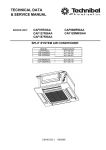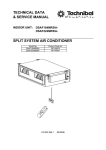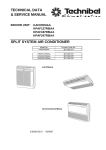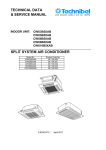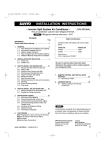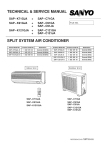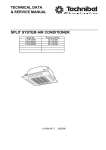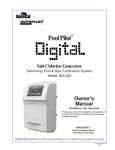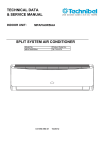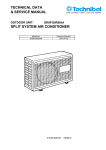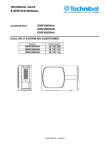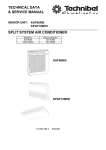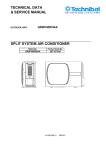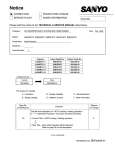Download technical data & service manual split system air conditioner
Transcript
TECHNICAL DATA & SERVICE MANUAL INDOOR UNIT: CAF184MR5IA- SPLIT SYSTEM AIR CONDITIONER Model No. CAF184MR5IA- Product Code No. 387106971 0.8180.393.1 09/2006 • Ground the unit following local electrical codes. • The Yellow/Green wire cannot be used for any connection different from the ground connection. • Connect all wiring tightly. Loose wiring may cause overheating at connection points and a possible fire hazard. • Do not allow wiring to touch the refrigerant tubing, compressor, or any moving parts of the fan. • Do not use multi-core cable when wiring the power supply and control lines. Use separate cables for each type of line. IMPORTANT! Please read before installation This air conditioning system meets strict safety and operating standards. For the installer or service person, it is important to install or service the system so that it operates safely and efficiently. For safe installation and trouble-free operation, you must: • Carefully read this instruction booklet before beginning. • Follow each installation or repair step exactly as shown. • Observe all local, state and national electrical codes. • Pay close attention to all warning and caution notices given in this manual. •The unit must be supplied with a dedicated electrical line. When transporting Be careful when picking up and moving the indoor and outdoor units. Get a partner to help, and bend your knees when lifting to reduce strain on your back. Sharp edges or thin aluminium fins on the air conditioner can cut your fingers. WARNING When installing... ... In a ceiling or wall Make sure the ceiling/wall is strong enough to hold the unit-weight. It may be necessary to build a strong wooden or metal frame to provide added support. This symbol refers to a hazard or unsafe practice which can result in severe personal injury or death. ... In a room Properly insulate any tubing run inside a room to prevent "sweating", which can cause dripping and water damage to walls and floors. CAUTION This symbol refers to a hazard or unsafe practice which can result in personal injury or product or property damage. ... In moist or uneven locations Use a raised concrete base to provide a solid level foundation for the outdoor unit. This prevents damage and abnormal vibrations. If necessary, get help These instructions are all you need for most installation sites and maintenance conditions. If you require help for a special problem, contact our sale/service outlet or your certified dealer for additional instructions. ... In area with strong winds Securely anchor the outdoor unit down with bolts and a metal frame. Provide a suitable air baffle. In case of improper installation The manufacturer shall in no way be responsible for improper installation or maintenance service, including failure to follow the instructions in this document. ... In a snowy area (for heat pump-type systems) Install the outdoor unit on a raised platform that is higher than drifting snow. Provide snow vents. SPECIAL PRECAUTIONS When connecting refrigerant tubing • Keep all tubing runs as short as possible. • Use the flare method for connecting tubing. • Apply refrigerant lubricant to the matching surfaces of the flare and union tubes before connecting them; screw by hand and then tighten the nut with a torque wrench for a leak-free connection. • Check carefully for leaks before starting the test run. • During installation, connect before the refrigerant system and then the wiring one; proceed in the reverse orden when removing the units. WARNING When wiring ELECTRICAL SHOCK CAN CAUSE SEVERE PERSONAL INJURY OR DEATH. ONLY A QUALIFIED, EXPERIENCED ELECTRICIANS SHOULD ATTEMPT TO WIRE THIS SYSTEM. NOTE: Depending on the system type, liquid and gas lines may be either narrow or wide. Therefore, to avoid confusion, the refrigerant tubing for your particular model is specified as narrow tube for liquid, wide tube for gas. • Do not supply power to the unit until all wiring and tubing are completed or reconnected and checked, to ensure the grounding. • Highly dangerous electrical voltages are used in this system. Carefully refer to the wiring diagram and these instructions when wiring. Improper connections and inadequate grounding can cause accidental injury and death. When servicing • Turn the power OFF at the main power board before opening the unit to check or repair electrical parts and wiring. • Keep your fingers and clothing away from any moving parts. • Clean up the site after the work, remembering to check that no metal scraps or bits of wiring have been left inside the unit being serviced. • Ventilate the room during the installation or testng the refrigeration system; make sure that, after the installation, no gas leaks are present, because this could produce toxic gas and dangerous if in contact with flames or heat-sources. 2 Table of Contents Page 4 4 5 6 1. SPECIFICATIONS 1-1 Unit specifications 1-2 Major Component specifications 1-3 Other Component specifications 2. DIMENSIONAL DATA 7 3. ELECTRICAL DATA 8 8 3-1 Electric Wiring Diagrams 9 9 11 12 4. FUNCTION 4-1 Operation Functions 4-2 Protective Functions 4-3 Drain Pump and Float Switch 5. TROUBLESHOOTING 13 6. CHECKING ELECTRICAL COMPONENTS 17 17 18 18 6-1 Measurement of Insulation Resistance 6-2 Checking Continuity of Fuse on PCB Ass'y 6-3 Checking Motor Capacitor 3 1. SPECIFICATIONS 1-1 Unit Specifications CAF184MR5IAPower source 220 - 240 V ~ 50 Hz Voltage rating 230 V Performance Capacity Air circulation High/Med./Low m³/h Features Controls/Temperature controls Control unit Timer Fan speed Airflow direction Air Filter Power noise level Refrigerant tubing connections Refrigerant tube diameter Refrigerant Refrigerant tube kit / Air clean filter Dimensions & Weight Dimensions Unit Ceiling panel Package dimensions Unit Ceiling panel Weight Unit Ceiling panel See catalogue with the requested matching 790/660/580 Microprocessor/ I.C. thermostat Wireless remote control unit ON/OFF 24 hours & Daily program, 1-hour OFF 3 and Auto /1(Hi) Auto Vertical High/Med./Low dB-A Narrow tube Wide tube mm(in.) mm(in.) Height Width Depth Height Width Depth Height Width Depth Volume Height Width Depth Volume Net Shipping Net Shipping mm mm mm mm mm mm mm mm mm m3 mm mm mm m3 kg kg kg kg 4 Washable, Anti-Mold 54/49/46 Flare type 6,35 (1/4) 9,52 (3/8) R410A Optional / -------------- 273 575 575 64 730 730 380 744 650 0,18 110 800 800 0,07 18,2 22,7 2,50 4,70 1-2 Major Component Specifications CAF184MR5IAController PCB Part No. Controls Control circuit fuse CB-XMRV183EH Microprocessor 250 V - 3,15 A Remote Control Unit RCS-3MVHPS4E Fan & Fan Motor Type Q'ty ……. Dia. and lenght Fan motor model…Q'ty No. of poles…rpm (230 V, High / 2nd / 3rd / Low) Running Amps Power input Coil resistance (Ambient temp. 20 °C ) Safety devices mm A W Ω Type Operating temp. Open Close °C Run capacitor µF VAC Flap Motor Type Model Rating Coil resistance (Ambient temp. 25 °C ) Ω Heat Exch. Coil Coil Rows Fin pitch face area Centrifugal fan 1…. Ø 280 / L 166 K35407 M01972 …1 4… 880 / 740 / 660 / 290 0,27 61 BLU-BRN: 33,9÷39,1 BLU-BLK: 325÷374 BLK-GRY: 78,7÷90,5 GRY-RED: 49,7÷57,2 RED-WHT/YEL: 155÷178 Internal thermal protector 150 ± 10 Automatic 2 400 Stepping motor MP24GA2 DC 12 V 400±7% Aluminium plate fin / Copper tube 1 1,3 mm 0,258 m2 DATA SUBJECT TO CHANGE WITHOUT NOTICE 5 1-3 Other Component Specifications Trasformer (TR) Rating CAF184MR5IA- ATR-I55 AC 230 V, 50/60 Hz 13.7 V - 0.4 A 5.48 VA Primary (WHT-WHT): 307 ± 10% Secondary (BRN-BRN): 1.8 ± 10% 150°C Primary Secondary Capacity Ω (at 25°C) Coil resistance Thermal cut-off temp. Thermistor ( Coil sensor TH1) Resistance κΩ DTN-C583G3U-TKS121B 0 °C: 188,0 ± 4% Thermistor ( Room sensor TH2) Resistance κΩ DTN-C502H3T-TKS128B 25 °C: 5,0 ± 3% Drain pump Model Rating PC 309564003 220-240 V - 50 Hz 14 W 0,4 l/min Voltage Input Total head capacity Safety float switch Model Contact rating BI 1300 2725 230 V AC/DC - 0,5 A • Indoor heat exchanger sensor • Indoor air temp sensor 10 200 9 180 160 Resistance (Ω) Resistance (Ω) 8 7 6 5 4 3 140 120 100 80 60 2 40 1 20 10 15 20 25 30 35 Temperature (°C) 0 40 6 0 10 20 30 40 50 60 70 80 90 Temperature (°C) 2. DIMENSIONAL DATA Unit: mm 7 3. ELECTRICAL DATA 3-1 Electric Wiring Diagrams 8 4. FUNCTIONS 4-1. Operation Functions ■ Functions of the main unit controller ■ SENSOR DRY 1 OFF : • Used to stop the unit when the remote (Self-diagnostics) controller is unavailable. • Used when service inspection is performed. 2 ON : • During normal operation: Starts operation from the remote controller. • Emergency operation: When the remote controller is unavailable, moving this switch from the OFF position to the ON position starts automatic operation. 3 TEST : • Used when operating performance are checked. • Used when pump-down is carried out. (Operates at the rated frequency. At this time, the main unit lamp flashes, and the remote controller signal cannot be received.) 4 DEMO : • This function is for shop displays. Ordinarily it is not used. • Used during servicing. During automatic operation, the system adjusts the room temperature and fan speed according to the conditions in the room, in order to maintain a comfortable room environment. SENSOR DRY operation • DRY operation is as shown in the figure below. Load COOL zone A zone B zone Conditions are monitored at all times when the room temperature is below 15°C. DRY A The compressor operation frequency varies depending on the relative humidity. The indoor fan operates with 1/f fluctuation. ■ Automatic operation ● Operating mode selection When automatic operation is selected, the indoor and outdoor temperature sensors function, and either HEAT, DRY, or COOL mode operation is selected automatically. Set temperature (standard) Indoor temperature Outdoor air temperature (Approx.) 15°C 22°C 27°C (Approx.) COOL mode 22°C DRY mode 20°C 18°C HEAT mode DRY B The compressor operates at a low operating frequency. The indoor fan operates with 1/f fluctuation. Monitor • Monitoring operation takes place when the room temperature is below 15°C. • When the monitoring range is entered, the compressor stops, and the indoor fan operates at LL. 27°C Temperature at which operation starts (Range: 20 – 26°C) ■ PAM-α control • In order to further improve inverter performance, control is switched between PWM control at low operation speeds, and PAM control at high operation speeds, making the most effective use of power. 24°C • When multiple indoor units are connected and this unit is started while another indoor unit is operating, the operating mode is as shown in the table below. Multi operating mode Operating mode after change COOL DRY DRY DRY COOL HEAT HEAT DRY HEAT HEAT Operating mode before change HEAT • If the remote controller is used to start automatic operation, a differing-mode check is performed if the operating modes are not the same. ● Desired-temperature memory • The set temperature in the program can be changed as desired within the range of ±4°C. This temperature can then be stored. During automatic operation, press the temperature setting buttons to change the temperature. 9 ■ HIGH POWER ■ Lamp colors Raises the power but remains in the same operating mode. This function is set with the HIGH POWER button on the remote controller. (It is set regardless of the temperature and fan speed settings.) Operation lamp HEAT operation : Red DRY operation : Orange ● HIGH POWER operation from the remote controller The unit operates at maximum output for 15 minutes, regardless of the desired temperature. The fan speed is 1 step above “High.” COOL operation : Green TIMER lamp : Green ■ ON timer operation Frequency MAX • Operation starts when the time set for the ON timer is reached. When a time is set, the TIMER lamp illuminates. • The below comfort timer programming is performed. A comfort time is calculated from the set temperature and the room temperature, either 60 minutes prior or 30 minutes prior to the set ON timer time, and operation is started in advance of the set ON time. (The indoor fan speed is “Medium.”) [COOL] Indoor temperature – Set temperature = Temperature difference [HEAT] Set temperature – Indoor temperature = Temperature difference Time 0 15 min. Start 5 min. End NOTE • When HIGH POWER operation ends, the unit operates at low Hz for 5 minutes, regardless of the thermostat OFF conditions. • When in DRY mode, operation is in the cooling zone. • When in HEAT mode, defrosting does not occur during HIGH POWER operation. • If HIGH POWER is set while defrosting is in progress, HIGH POWER operation begins after defrosting ends. • HIGH POWER operation cannot be set from the remote controller when the unit is stopped. • HIGH POWER operation and ECONOMY operation cannot be used at the same time. The function set last takes priority. Temperature difference (°C) Advance start time (min.) 12 < Temperature difference 60 6 < Temperature difference 30 NOTE This function does not operate if the ON timer standby time is less than 30 minutes. ■ OFF timer operation • Operation stops when the time set for the OFF timer is reached. When a time is set, the TIMER lamp illuminates. ■ ECONOMY • When ECONOMY operation is set, the temperature and fan speed settings will be adjusted automatically to allow comfortable sleep. • When ECONOMY operation is set, “ mark” appears on the remote controller. ■ Timer backup • If the indoor unit is unable to receive the timer time-end signal when the ON or OFF time is reached, then timer time-end occurs according to the indoor unit backup timer within approximately 26 minutes. • Operation stops if there are no operator controls for 25 hours or longer after unit operation switched from OFF to ON by use of ON timer operation. ● COOL and DRY modes • The indoor unit fan speed is automatically lowered for quiet operation. • The temperature setting is raised by 1°C one hour after ECONOMY operation is set. ● HEAT mode • The indoor unit and outdoor unit fan speeds are automatically lowered for quiet operation. • The temperature setting is lowered by 3°C one hour after ECONOMY operation is set. In addition, the temperature setting is lowered by 4°C after two hours have passed. 10 4-2. Protective Functions ■ Cold-air prevention during heating During HEAT operation, the temperature of the indoor heat exchanger is used to control the frequency and lessen the load on the compressor before the protective device is activated. During heating, the fan speed is set to “LL” (very low) or stopped. As the temperature of the indoor heat exchanger rises, the fan speed is changed to the set speed. Indoor heat exchanger temperature (°C) ■ Overload prevention during heating Indoor heat exchanger A. Control start B. Control end A Approx. 53 Approx. 47 Normal operation B a b c At start of operation d a area: Automatic capacity control b When Point A has been exceeded, the operation frequency is LL reduced by a certain proportion. Stopped c area: Frequency increase is prohibited. d At Point B and below, overload prevention is ended and Indoor heat exchanger temperature (°C) During COOL or DRY operation, freezing is detected and operation is stopped when the temperature of the indoor heat exchanger matches the conditions below. 1 Freeze-prevention operation is engaged when the temperature of the indoor heat exchanger is below 6°C. 2 Restart after freeze-prevention operation occurs when the temperature of the indoor heat exchanger reaches 8°C or above. • This prevents remote controller signal interference when two air conditioners are installed next to each other. Ordinarily, the address is set to A. If it is necessary to change the address, follow the procedure below. If 3 or more (up to 4) units are installed, use remote controllers that are intended for servicing use. 1 Switch the address setting to “B” by removing the tab marked “A” on the remote controller. 2 Insert dry-cell batteries into the remote controller and press the ACL button. Then attach the cover. 3 Open the air intake grille on the indoor unit, and move the operation switch to the DEMO position. 4 Press the ON/OFF operation button on the remote controller. Check that the “beep” signal-received sound is heard from the indoor unit. 5 Move the operation switch to the ON position, and close the intake grille. 6 Operate the remote controller. Check that the “beep” signalreceived sound is heard from the indoor unit. B 2 * a b c d a area: Automatic capacity control b When the temperature drops below Point A, the operation frequency is reduced by a certain proportion. c area: Frequency increase is prohibited. d When the temperature reaches Point C or above, freezing prevention is ended and control is the same as in the a area. * Approx. 40 ■ Changing the remote controller address C A 30 NOTE • The fan speed is forcibly changed to “LL” beginning 30 seconds after the thermostat turns OFF. • Normal operation refers to operation when the room temperature has approached the set temperature. • When HEAT operation starts, the indoor fan is stopped until the temperature of the indoor heat exchanger reaches 20°C or higher, or until the room temperature reaches 15°C or higher. ■ Freeze prevention 8 25 Indoor heat exchanger temperature (°C) control is the same as in the (a) area. 6 Set fan speed High When the temperature drops to below 2°C (continuously for 2 minutes or longer), the compressor stops. Once the freeze condition is detected, the air conditioner will work less than the maximum frequency until it is turned off. 11 4-3. Drain Pump and Float Switch 5. TROUBLESHOOTING ■ Precautions before performing inspection or repair ● After checking the self-diagnostics monitor, turn the power OFF before starting inspection or repair. ● High-capacity electrolytic capacitors are used inside the outdoor unit controller (inverter). They retain an electrical charge (charging voltage DC 280 V) even after the power is turned OFF, and some time is required for the charge to dissipate. Be careful not to touch any electrified parts before the controller LED (red) turns OFF. If the outdoor controller is normal, approximately 30 seconds will be required for the charge to dissipate. However, allow at least 5 minutes for the charge to dissipate if there is thought to be any trouble with the outdoor controller. After inspection or repair is completed, be sure to move the operation switch to the DEMO position, turn the power ON, and erase the diagnostics contents. ■ Method of self-diagnostics If the indoor unit operation lamp is flashing every 0.5 seconds, follow the procedure below to perform detailed trouble diagnostics. NOTE 1: If the operation lamp flashes every 0.5 seconds immediately when the power is turned ON, there is an external ROM (OTP data) failure on the indoor circuit board or a board insertion problem, or the board has not been installed. 2: The failure mode is stored in memory even when the power is not ON. Follow the procedure below to perform diagnostics. PROCEDURE 1 Turn the power switch ON. 2 Move the operation selector on the remote control receiver to OFF (self-diagnostics). 3 If there is a sensor failure or a protective function has activated, self-diagnostics lamps 1, 2, and 3 will illuminate in the following pattern: 5 seconds flashing (illuminated) + 2 seconds OFF. (Buzzer sounds once while lamps are OFF.) Note: If there is no trouble, then self-diagnostics lamps 1, 2, and 3 do not illuminate, and the buzzer does not sound. 4 Diagnostics is completed when the buzzer sounds 3 beeps. 5 After inspection or repair is completed, be sure to move the operation switch on the indoor unit main body to the DEMO position, turn the power ON, and erase the diagnostics contents. Then move the operation selector on the remote control receiver to the OFF position and check that the diagnostics contents have been erased before using the unit. <Indoor unit main body> Operation switch Ordinarily, be sure this is always set to NORMAL. The DEMO position is used for inspections and similar maintenance. 13 Operation selector Ordinarily, be sure this is always set to ON. The OFF and TEST positions are used for inspections and similar maintenance. Details of Self-Diagnostics When the operation selector on the grille assy is moved from the ON or TEST position to the OFF (Self-diagnostics) position, the indicator lamps will flash (or remain ON) for 5 seconds and then turn OFF for 2 seconds (buzzer sounds once) to indicate the presence of a sensor failure or the activation of a protective function. Self-diagnostics is completed when the buzzer sounds 3 beeps. If there is no trouble, the lamps do not flash. Also note that the corresponding parts listed below may not be present in some models. * Other : Timer lamp flashes (3-second intervals): I/D float switch activated. NOTE : If the operation lamp continues to flash (orange) even when the operation switch has been moved to the OFF position, an indoor unit external ROM failure has occurred. (E14) After inspection or repair is completed, be sure to move the operation switch (on the electrical box) to the DEMO position, turn the power OFF and ON and erase the diagnostics contents. Control 1 * Initial selfdiagnostics Only operation lamp illuminates Short-circuit terminals 2 and 4 on the indoor unit terminal plate No change Change: Operation lamp and Service lamp illuminate, and Timer lamp flashes Change: Operation lamp and Service lamp illuminate, and Timer lamp flashes Control 2 Short-circuit terminals 2 and 3 on the outdoor unit terminal plate Change: Operation lamp and Service lamp illuminate, and Timer lamp flashes Change: only operation lamp illuminates Probable location of malfunction Indoor unit circuit board failure Outdoor unit circuit board failure Failure (open circuit, contact failure, etc.) in the inter-unit cable - Turn the power OFF before performing short circuiting work. - During the self-diagnostics check, the check results are the first indication when the operation switch is moved to OFF while the indicators are flashing after power ON →DEMO (5 seconds) →ON. - Before performing the above checks, perform DEMO operation, and check that AC 220 V is output toterminals 1 and 2. If it is not output, there is a failure related to the indoor unit power. 14 ■ If the self-diagnostics function fails to operate • No indicators illuminate and the indoor fan does not turn. • Check the power voltage. Check the indoor unit. Blown Is the fuse blown? Normal Replace the circuit board or the fuse. Replace the controller. <Checking the indoor and outdoor units> ■ Checking the indoor unit No. Control Check items (unit operation) 1 Set operation selector of indoor unit main body to DEMO and start operation using the remote controller. • The rated voltage must be present between inter-unit cables 1 and 2. • Connect a 5 kΩ resistor between inter-unit cables 2 and 3. When the voltage at both ends is measured, approximately 12–15 V DC must be output and the needle must fluctuate once every 8 seconds. In addition, insert an LED jig and check that the LED flickers once every 8 seconds. ● If there are no problems with the above, then check the outdoor unit. ■ Checking the outdoor unit No. Control Check items (unit operation) 1 Apply the rated voltage between outdoor unit terminals 1 and 2. • The control panel LED (red) must illuminate. 2 Short-circuit the outdoor unit COM terminal to the T-RUN terminal. • The compressor and fan motor must turn ON. ● If there are no problems with the above, then check the indoor unit. TEST/T-RUN terminals ● Using the TEST/T-RUN terminals T-RUN : Test run (compressor and fan motor turn ON.) TEST/MV : Compresses time to 1/60th (accelerates operation by 60 times faster than normal). Fully opens the electric expansion valve. 15 <Noise malfunction and electromagnetic interference> An inverter A/C operates using pulse signal control and high frequencies. Therefore, it is susceptible to the effects of external noise, and is likely to cause electromagnetic interference with nearby wireless devices. A noise filter is installed for ordinary use, preventing these problems. However, depending on the installation conditions, these effects may still occur. Please pay attention to the points listed below. ■ Noise malfunction This refers to the application of high-frequency noise to the signal wires, resulting in abnormal signal pulses and malfunction. Locations most susceptible to noise 1. Locations near broadcast stations where there are strong electromagnetic waves 2. Locations near amateur radio (short wave) stations 3. Locations near electronic sewing machines and arc-welding machines Trouble Either of the following trouble may occur. 1. The unit may stop suddenly during operation. 2. Indicator lamps may flicker. Correction (The fundamental concept is to make the system less susceptible to noise.) — Insulate for noise or distance from the noise source. — 1. Use shielded wires. 2. Move unit away from the noise source. ■ Electromagnetic interference This refers to the noise generated by high-speed switching of the microcomputer and compressor. This noise radiates through space and returns to electric wiring, affecting any wireless devices (televisions, radios, etc.) located nearby. Locations most susceptible to noise 1. A television or radio is located near the A/C and A/C wiring. 2. The antenna cable for a television or radio is located close to the A/C and A/C wiring. 3. Locations where television and radio signals are weak. Trouble Correction 1. Noise appears in the television picture, 1. Select a separate power source. or the picture is distorted. 2. Keep the A/C and A/C wiring at least 1 meter 2. Static occurs in the radio sound. away from wireless devices and antenna cables. 3. Change the wireless device's antenna to a highsensitivity antenna. 4. Change the antenna cable to a BS coaxial cable. 5. Use a noise filter (for the wireless device). 6. Use a signal booster. 16 6. CHECKING ELECTRICAL COMPONENTS 6-1. Measurement of Insulation Resistance power plug (Local supply) ● The insulation is in good condition if the resistance exceeds 2MΩ. Ground probe 6-1-1. Power Supply Wires Clamp the grounding terminal of the power plug with a lead clip of the insulation resistance tester and measure the resistance by placing a probe on both the two power terminals. (Fig. 1) Insulation tester NOTE The shape of the power plug may differ from that of the air conditioner which you are servicing. Fig. 1 Then, also measure the resistance between the grounding and other power terminals. (Fig. 1) Terminal plate 6-1-2. Indoor Unit Probe Clamp a metallic part of the unit with the lead clip of the insulation resistance tester and measure the resistance by placing a probe on each terminal screw where power supply lines are connected on the terminal plate. (Fig. 2) Clip 6-1-3. Outdoor Unit Copper tube or metallic part Insulation tester Fig. 2 Clamp an aluminum plate fin or copper tube with the lead clip of the insulation resistance tester and measure the resistance by placing a probe on each terminal screw on the terminal plate. (Fig. 2) Note that the ground line terminal should be skipped for the check. Probe Clip 6-1-4. Measurement of Insulation Resistance for Electrical Parts Copper tube or metallic part Disconnect the lead wires of the desired electric part from terminal plate, capacitor, etc. Similarly disconnect the connector. Then measure the insulation resistance. (Figs. 3 and 4) Insulation tester Fig. 3 From fan motor, compressor and other parts NOTE Refer to Electric Wiring Diagram. If the probe cannot enter the poles because the hole is too narrow then use a probe with a thinner pin. Metallic part Probe Clip Insulation tester Fig. 4 17 7-2. Checking Continuity of Fuse 6-2. on PCB Ass'y Fuse ● Remove the PCB Ass’y from the electrical component box. Then pull out the fuse from the PCB Ass’y. (Fig. 5) PCB Ass’y ● Check for continuity using a multimeter as shown in Fig. 6. Fig. 5 6-3. 7-3. Checking Motor Capacitor Remove the lead wires from the capacitor terminals, and then place a probe on the capacitor terminals as shown in Fig. 7. Observe the deflection of the pointer, setting the resistance measuring range of the multimeter to the maximum value. Fuse Fig. 6 The capacitor is “good” if the pointer bounces to a great extent and then gradually returns to its original position. The range of deflection and deflection time differ according to the capacity of the capacitor. Multimeter Compressor motor capacitor Fan motor capacitor Fig. 7 18 R.D. 28 Reyrieux BP 131 - 01601 Trévoux CEDEX France Tél. 04.74.00.92.92 - Fax 04.74.00.42.00



















